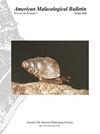新发现:圆锥虫幼虫和卵壳的观察及其对圆锥虫软体动物起源的启示
IF 0.4
4区 生物学
Q4 MARINE & FRESHWATER BIOLOGY
引用次数: 3
摘要
摘要/ Abstract摘要:根据美国佛罗里达州Sanibel岛的资料,首次描述了捕食性腹足类Conus spurius Gmelin, 1791的veliconcha幼虫。孵化螺长1470 ~ 1570 μm(平均1530 μm),第一原螺最大直径670 ~ 740 μm(平均710 μm),卵直径570 μm。Veliconchas可以游泳几分钟到几个小时,然后就会沉下来。它们具有发育良好的成对腭瓣,每片长度为600-700 μm,可伸展的足部,具有明显的后足部,通过横向褶皱与足部的其余部分分开。棘球绦虫的几个早期生活史特征,特别是孵化成以卵泡营养为主,几乎非浮游生物发育的大型veliconcha幼虫,与Conus Linnaeus(1758种,捕食其他腹足类动物)的一个定义明确的分支非常相似。它们与这个高度多样化的属中的大多数物种形成鲜明对比,这些物种孵化成更小的浮游生物,强制性的浮游营养型veliger幼虫。成年后,它们组成了一个以蠕虫为食的觅食行会,只捕食或几乎捕食多毛纲环节动物。有限的数据表明,C. spurius可能与它们共享这一特征,但它也可能捕食软体动物。最近的分子系统发育树表明,“远洋发育”和“非远洋发育”(或接近:<1天)的特征在包括C. spurius和软体动物物种在内的较大分支中独立于系统发育而分布。在齿齿形态和发育模式、成虫齿形态、系统发育位置和最早的化石记录方面的相似性表明,现存的软体动物Conus物种的单系分支可能是在中新世从具有这些特征的蚓食或混合蚓食-软体动物祖先进化而来的,如C. spurius。本文章由计算机程序翻译,如有差异,请以英文原文为准。
A Veliconcha Unveiled: Observations on the Larva and Radula of Conus spurius, with Implications for the Origin of Molluscivory in Conus
Abstract:
The veliconcha larva of the predatory gastropod Conus spurius Gmelin, 1791 is described and for the first time illustrated based on material from Sanibel Island, Florida. Hatchling veliconchas were 1470–1570 μm (mean = 1530) long, with first protoconch whorl maximum diameter 670–740 μm (mean = 710), and estimated egg diameter 570 μm. Veliconchas can swim for a few minutes to a few hours before settling. They have well-developed paired velar lobes each 600–700 μm in length, an extensible foot with a distinct metapodium separated from the remainder of the foot by a transverse fold, and operculum. Several early life history traits of C. spurius, particularly hatching as large veliconcha larvae with predominantly lecithotrophic, nearly non-planktonic development, closely resemble those of a well-defined clade of Conus Linnaeus, 1758 species that prey on other gastropods. They contrast with the majority of species in this hyperdiverse genus, which hatch as much smaller planktonic, obligatory planktotrophic veliger larvae. As adults they comprise a vermivorous feeding guild, preying exclusively or nearly so on polychaete annelids. Limited data suggest that C. spurius may share this trait with them but it may also prey on molluscs. Recent molecular phylogenetic trees suggest that the characters “pelagic development” and “non-pelagic development” (or nearly so: <1 day) are distributed independently of phylogeny in the larger clade that includes C. spurius and the molluscivorous species. Similarities in veliconcha morphology and developmental mode, adult radular tooth morphometry, phylogenetic position, and earliest fossil records suggest the speculative hypothesis that the monophyletic clade of extant molluscivorous Conus species may have evolved in the Miocene from a vermivore or mixed vermivorous-molluscivorous ancestor with these attributes, such as C. spurius.
求助全文
通过发布文献求助,成功后即可免费获取论文全文。
去求助
来源期刊
CiteScore
1.00
自引率
40.00%
发文量
1
审稿时长
>12 weeks
期刊介绍:
The American Malacological Bulletin serves as an outlet for reporting notable contributions in malacological research. Manuscripts concerning any aspect of original, unpublished research,important short reports, and detailed reviews dealing with molluscs will be considered for publication. Recent issues have included AMS symposia, independent papers, research notes,and book reviews. All published research articles in this journal have undergone rigorous peer review, based on initial editor screening and anonymous reviewing by independent expertreferees. AMS symposium papers have undergone peer review by symposium organizer, symposium participants, and independent referees.

 求助内容:
求助内容: 应助结果提醒方式:
应助结果提醒方式:


